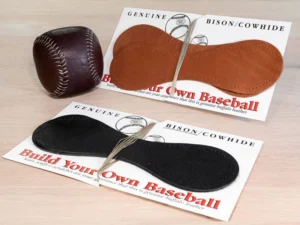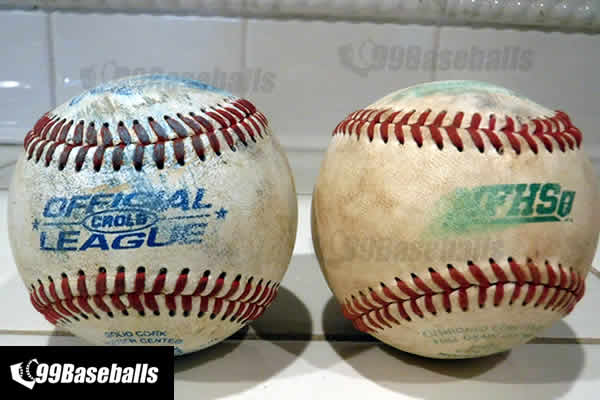
KEY TAKEAWAYS
- Understand the different types of materials used in making baseball covers
- Key items to be aware when buying baseballs
TABLE OF CONTENTS
- Introduction
- Leather Classifications
- How to Tell
- Advantages and Disadvantages
- Summary
- Interesting Facts
- Reference Links
- Frequently Asked Questions
INTRODUCTION
A baseball is made of three parts:
- Outer layer – leather “cover”
- Middle layer – thread and/or yarn
- Inner layer – pill (a ball made of rubber and/or cork in varying mixture combination and sizes
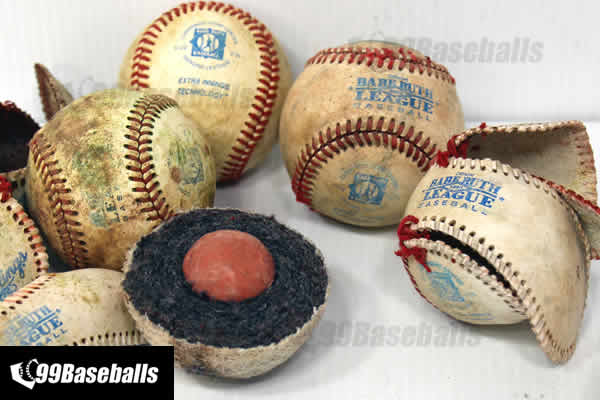
In this post, we will review the types of materials used for the outer layer of a baseball.
You might be thinking why do I even need to know this?
There is no industry standard terminologies used to describe natural and artificial leather, you may find yourself being hoodwinked by a manufacturer using confusing terms to think that you are getting a great deal when buying that bucket of baseball.
Because you can’t see the inside of a baseball, we tend to rely on how a particular baseball feels.
Most rec leagues (and tournament teams) do not provide you with practice balls so most managers and coaches pay for their own.
By knowing some key differences between real leather baseballs and artificial leather baseballs will help you make a sound buying decision for your particular team.
LEATHER CLASSIFICATIONS
As stated earlier, there is no industry standard terms to describe various leather types but through exhaustive research, I’ve done my best to logically divide them in to broad categories.
The material used in making baseball covers can be broken into two major categories:
- Natural Leather
- Synthetic Leather
Fun Project with Your Child
If you’re on the hunt for a fun DIY project to share with your child, the Buffalo Bill Company offers a leather cover kit for approximately $30. This isn’t an affiliate link; I’m just sharing something I found interesting.
For this project, you’ll need the inside part of a baseball, and you’ll be fitting it with this new leather cover. I recently purchased the tan version of this kit, so stay tuned as I’ll be sharing updates on our little DIY adventure soon.
Natural Leather
For over 7,000 years, earth’s civilization has been using leather to build clothing and other consumer goods.
Natural leather can be further broken into the following categories:
- Full-grain leather
- Top-grain/Corrected-grain leather
- Genuine leather
- Split-grain leather
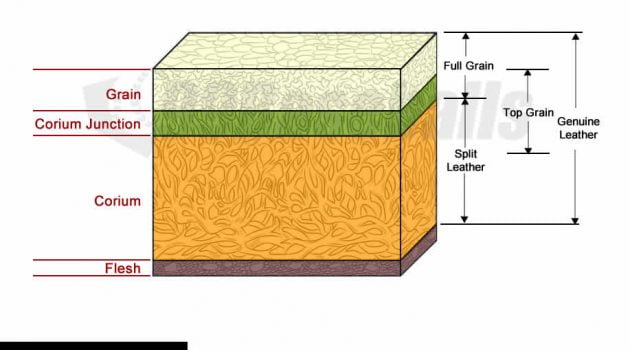
Full-grain leather
Full-grain leather is considered premium leather. It comes from the surface layer of a hide that has not been sanded or buffed out in any way.

Since the grain is left completely intact, the leather offers excellent strength, durability and breathability, all of which allows a baseball to display a beautiful wear during its lifetime.
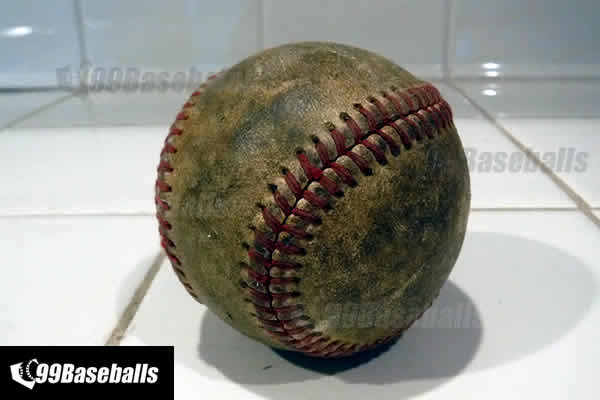
Top-Grain / Corrected-Grain Leather
Unlike full-grain leather, top-grain leather has been sanded and buffed to increase workability and also eliminate natural blemishes (by the way, this term is not the same as BLEM baseballs which contain manufacturing blemishes).
The sanding and buffing process tends to decrease pore sizes which provides greater water and stain resistance. Unfortunately, the same process also removes a thin layer so it decreases durability.
Split Leather
Split leather is a natural product (part of the corium layer; think suede) but it is normally bonded to a thin layer polyurethane film to make baseball cover.
We will need more about split leather baseball cover in the Synthetic Leather section below.
Genuine Leather
As you can see from the above diagram, “GENUINE LEATHER” encompasses the entire 3 layer of the skin so you would think this has to be the best natural leather, right?
Wrong!
This is one of those cases where manufacturers are trying to pull wool over customers’ eyes.
In almost all cases, baseball covers made from genuine leather are exclusively from the corium layer and much like split leather, it has to be bonded with several layers along with polyurethane or polyvinyl-chloride to give it strength and uniform appearance.
Please refer to the Synthetic Leather section for more information.
Leather used in MLB
The cowhide leather that covers ROMLB (Rawlings Official Major League Baseball) baseballs is a by-product from Cargill’s beef processing plan in Wyalusing, Pennsylvania.
Specifically, hides from Holstein dairy cows are referred by Rawlings because they tend to be thinner, have better grain and are cleaner and smoother than hides from other varieties.
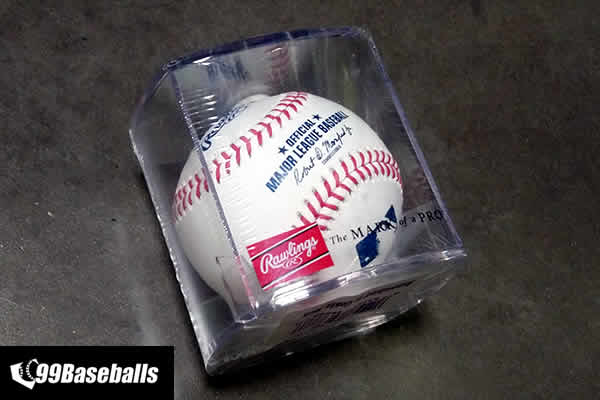
Because the leather used in making major league baseballs are aniline tanned (meaning the surface is completely left intact with all natural imperfections), Rawlings works extensively with local dairy farmers to minimize imperfections (i.e. bug bites).
These hides from Cargill are shipped off to Tennessee Tanning in Tullahoma, Tennessee (a wholly owned company by Rawlings) to be processed using alum tanning method which turns leather white.
Upon completion, hides are then shipped to Rawlings’ Turrialba, Costa Rica factory where baseballs are manufactured.
^^ Return to Leather Classification
Synthetic Leather
Synthetic leather can be made entirely from chemicals or by combining natural byproducts with chemicals.
Also referred to as faux or vinyl, synthetic leather products are classified into two main categories:
- Bicast leather
- Artificial leather
China is the largest producer of faux or synthetic leather and exports a lot of these products all over the world.
Bicast leather
Bicast leather can also be referred to as:
- Split leather
- Genuine leather
- Bonded leather
- Reconstituted leather
Split (and genuine) leather is 100% natural; however, because the surface of a split leather is rough (think suede), manufacturers normally apply a thin film of polymer to it before using it as a baseball cover.
Since split leather is more pliable than grain leather, it can be worked with polyurethane (PU) or polymer coating, artificial grain embossing, and spray-paint to create various leather “grains”.
Bicast leather is sometimes referred to as the true (i.e. legit) leather in comparison to faux leathers.
Most, if not all, bonded and reconstituted leathers are made from the scraps of leather waste, offcuts and fiber leftover from processing natural leather.
These scraps are first mixed with polyurethane binders, extruded, then rolled and pressed on to a substrate (i.e. fabric backing) with latex adhesives in between to produce a leather-like material.
Like bicast leather, a subsequent polyurethane coating may be applied and surface of the material plated (i.e. embossed) to simulate a natural-leather grain like texture.
It’s important to note that baseball covers made in this category only contain about 10-20 percent real leather.
^^ Return to Leather Classification
Artificial Leather
Artificial leather is made entirely from chemicals and are also commonly referred to as:
- Polyurethane leather (PU)
- Vinyl leather (PVC; polyvinyl chloride)
- Faux leather (a.k.a. pleather, synthetic, etc.)
In all cases, these artificial leather products are made from combining various thermoplastic polymers into a foam, then layered onto various fabric substrate to form a sheet of material.
Funnily enough, PU/Vinyl/Faux leather are completely artificial so some people considered it vegan (but not organic!)
^^ Return to Leather Classification
HOW TO TELL IF ITS REAL OR SYNTHETIC LEATHER?
Some synthetic baseballs are starting to look very close to real leather baseballs but there are some un-scientific ways to distinguish between two materials:
- Cost – how expensive are the balls? As of August 2022, you can expect to pay around $60 for a dozen baseballs with medium quality leather. Prices goes much higher for high quality baseballs used in high school, older tournaments and college
- Water test – apply few drops of water on to the surface of your baseball.
- Smell test – most synthetic baseballs come with chemical smells
- Batting test– Synthetic baseballs dot not have pores so any printed ink will simply dry on the surface of a ball. After a couple of round of hitting. if you notice any smearing, they are most likely made from synthetic covers
ADVANTAGES AND DISADVANTAGES
Natural Leather
Full-grain leather baseball
The holy grail leather of a classic baseball is the use of full-grain leather.. Not genuine leather. Not leather. Not Synthetic. FULL-GRAIN LEATHER.
Full-grain leather cover offers a thick skin that will endure multiple seasons without leaving stain marks on your bats.
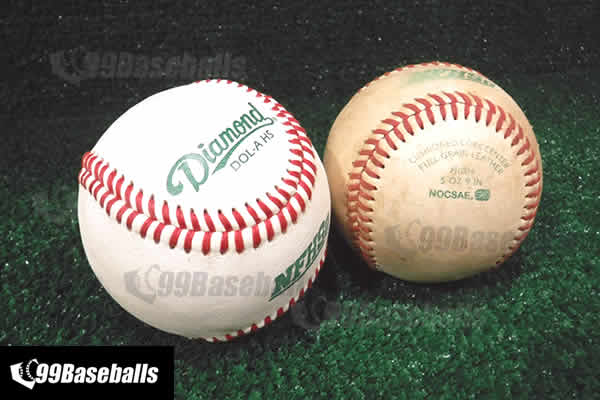
- Advantages – high durability; great feel when throwing; no bat staining; leather cover breathes so damp balls can dry
- Disadvantages – Some baseballs can wrinkle; will absorb water; leaving wet baseball in direct sun will shrink the cover (i.e. create gaps between seams); expensive
Top-grain/Corrected-grain leather baseball
A decent alternative to full-grain leather baseballs. However, due to sanding process, the pores of the leather are sealed and thickness may be reduced.
- Advantages – less expensive than full-grain; good durability; good feel when throwing; resists water
- Disadvantages – stamped logos tend to smear; wet baseballs will take a long time to dry
Bicast leather baseball
Split/genuine leather usually has a coating to emboss the natural-grain pattern.
- Advantages – good durability; high degree of water resistance when new
- Disadvantages – may have waxy (split/genuine) or plastic (bonded/reconstituted) feel; stamped logos may smear; does not breathe so internal moisture will take a long time to dry; may develop slickness over; time; bonded leather baseballs tend to delaminate and peel
Artificial Leather

PU leather baseball
- Advantages – 100% polyurethane are softer and closer to leather; inexpensive; does not absorb water; initially durable
- Disadvantages – chemical smell; slick when wet; stamped logos will smear; not UV resistant so the cover can crack after few months of use
PVC (vinyl) leather baseball
- Advantages – Vinyl fabrics is more durable than PU leather; low chemical smell; flat seams
- Disadvantages – slick when wet; stamped logos will smear; not UV resistant so the cover can crack after few months of use
SUMMARY
When buying practice or game balls for your child or team, I think it’s important to take a closer look at the cover material so that you can make a sound investment decision.
A good rule of thumb to remember is that when you are purchasing baseballs for the younger age group (think tee-ball, 7/8 year old league), most game balls will come with synthetic cover.
Most leagues will start to phase in genuine leather/top-grain level/full-grain baseballs as players get older.
I am just not fan of any plastic baseballs because they just feel so different when hitting and making throws.
I think Rawlings started to transition their CROLB from synthetic to “leather” cover last year with nominal increase in price so you may want to take a look it instead of buying R8U/R10U or OLB3 baseballs.
You can tell that a particular baseball is not made from real leather because baseballs made from bonded leather tends to feel waxy (from subsequent polyurethane coating I mentioned earlier) and after a couple of round of hitting, printed logos will start to smear and stain your bat.
The smearing occurs because reconstituted leather cover does not have pores, meaning any applied ink layer just sits on top of the surface.
Baseball covers made from real leather has microscopic sweat pores where ink can seep in. This is why you will see logos on MLB baseballs will fade but not smear.
If the material is thin, the cover will start to crack and peel soon after use.
| Please don’t forget to visit Buying Baseballs – Reference Articles page to read other fascinating information about baseballs! |
Frequently Asked Questions
- How thick is the leather on a baseball?
- Although it varies slightly from year to year, but it is generally 1.25mm which is in a 2-4oz thickness range
- How many baseballs can be made from a cow?
- You can make about 144 baseballs from a typical cowhide=
- What were baseballs made of before cowhide?
- Up until 1974, baseballs were made with horsehide. Due to difficulty in obtaining good quality leather, it was switched over to cowhide
- What baseballs are used in college?
- NCAA adopted Rawlings flat-seam baseballs starting February 2015. It comes with EIT (extended inning technology) and full-grain leather. All NCAA college baseballs also come with an official NCAA stamp. The specific model is FSR1NCAA
- How many MLB baseballs are produced each day?
- Rawlings’ Costa Rica plant produces about 36,000 MLB baseballs per day
- How much does it cost to make an MLB baseball?
- It costs about $8 per ball as of year 2022
- What baseball is used for high school?
- Most teams using Rawlings baseballs prefer EIT (extended inning technologies) baseballs which raised seams with full grain leather cover and 15% wool windings
- How many balls do they use in a World Series game?
- Surprisingly, a typical game at the College World Series requires only about 60 to 70 baseballs
- How many baseballs are prepared for each game?
- The home team usually prepares (i.e. applies a light coating of mud) around 150 baseballs for a regular season game. Any leftover balls are set aside for the next game
- Is MLB using 2 different balls?
- While players insisted that two different types of baseballs are used in the league, MLB stated that the league uses only one type, ROMLB baseballs and any discrepancies are due to supply chain issues
- Why do baseballs have red stitches?
- The original black and blue thread was ditched in favor of red because red was being used by both American and National league and the contrasting red on white surface was more visible
- Are MLB baseballs handmade?
- All ROMLB baseballs are still hand sewn in Costa Rica by 300 or so qualified craftsmen/women, producing approximately 2.4 million baseballs per year . The amateur baseballs we throw around in the backyard are mass produced primarily in China with some coming from Vietnam.
- What happens to discarded baseballs during a game? Does MLB reuse baseballs?
- Discarded baseballs are relegated to batting practice (in MLB and MiLB), or get authenticated and sold in MLB shops as used memorabilia. Some stadiums sell balls directly to attendees (like selling popcorn)
INTERESTING FACTS
- Play Ball – Cargill beef plant supplies Rawlings Sporting Goods Company
- How Baseballs are made – How Made
- Leather Head Sports makes baseballs the old-fashioned way – in Glen Rock NJ
REFERENCE LINKS
- Do You Know Your Full-grain from Your Bovine Splits? (Tusting.co.uk)
- Leather Tanning Explained
- The Real Life Story Of A Major League Baseball Revealed (Forbes)
- Horsehide vs Cowhide
- Prior to 1974, horsehide was used exclusively to make baseball leather covers. Starting in 1974, cowhide has been used to manufacture Rawlings MLB game balls due to the shortage in horsehide.
- Horsehide has high tensile strength than cowhide so it is more durable and less likely to crack and to boot, it is cheaper.
- However, you can’t play baseball games without baseballs so MLB stuck with cowhide. Cowhide is more expensive but they were plentiful so Rawlings can afford to be choosy to maintain high quality standards.
- The downside to cowhide is that it tends to be slicker than horsehide so in Japan, pitchers to favor horsehide baseballs made by Mizuno / SSK.
- Genuine Leather vs Full-Grain Leather vs Premium Leather
- Generally speaking, the leather industry classifies five types of leather grades: bonded, genuine leather, split-grain leather, full-grain leather, and top-grain leather.
- Regardless of the type, a genuine leather cover is long-lasting and are the traditional choice for many youth baseball teams due to better grip and proven durability.
- The least expensive baseballs from natural leather will be made from genuine leather (bonded leather has synthetic backing cloth).
- Full-grain leather and premium leather are the same, which is the outermost layer of the hide that is considered to be most durable and breathable (less tendency to hold moisture or sweat).
- The stamp on baseballs will be marked with “Genuine Leather”, “Full Grain Leather”, or “Premium Leather”.
- Unfortunately, genuine leather comes with varying thickness and quality so the obvious difference between a high quality genuine leather baseball vs. a lower quality leather is the price.
- Synthetic leather covers are made from various vinyl and vinyl-like materials. It can be confusingly referred to as Vyntan, synthetic leather, soft leather, etc. It resists dirt and does not absorb water as much as leather.
- Most, if not all, game baseballs have genuine leather cover; synthetic baseballs are usually relegated to practice (they are great for practice after rain because they do not absorb water as quickly as the genuine leather cover baseballs.

